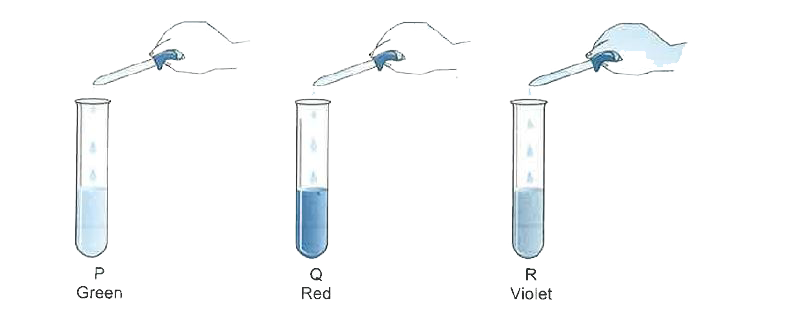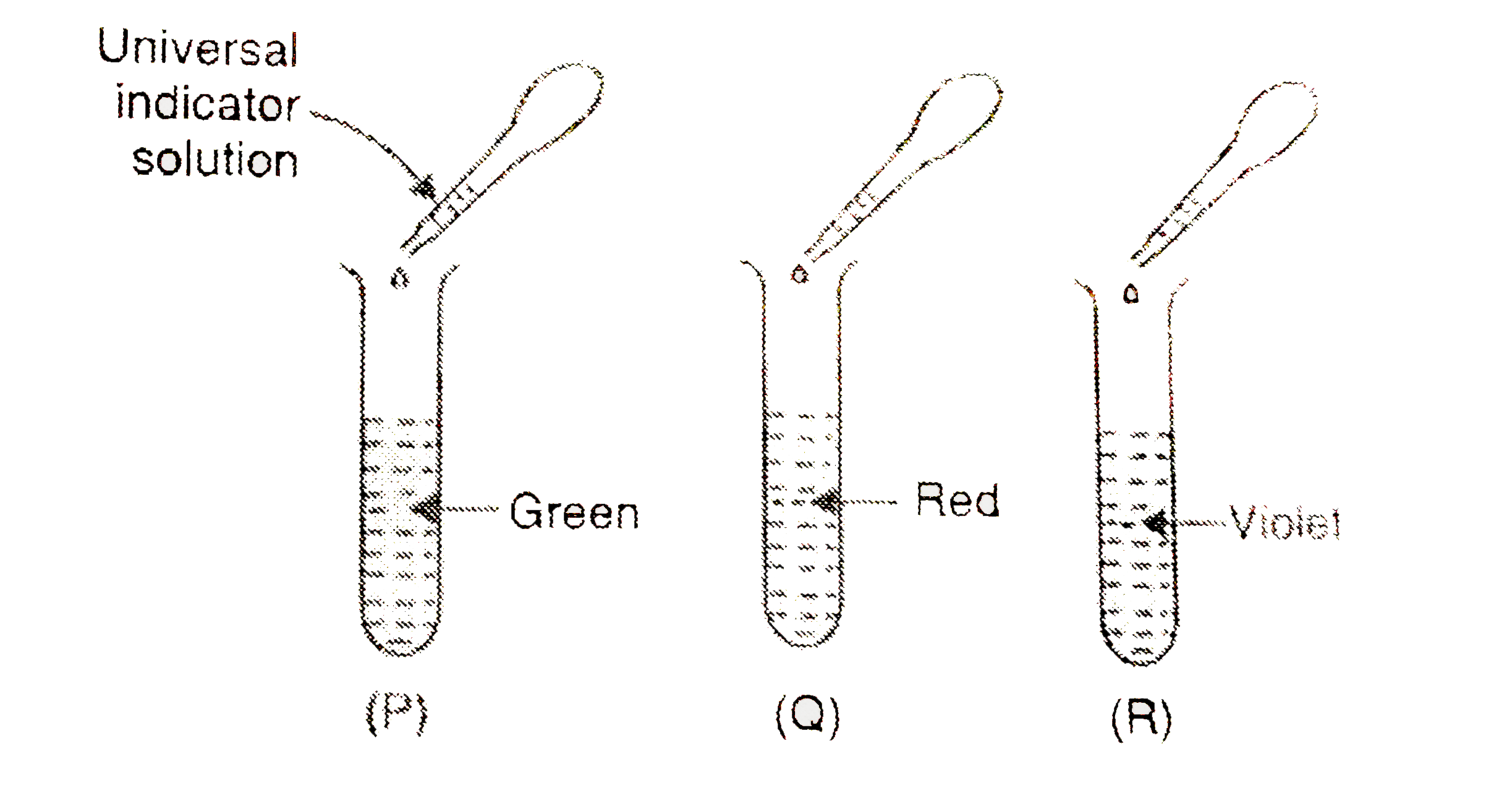A science teacher labelled three glass slides as P Q and R. She painted slide Q with light blue colour, slide R with black colour and slide P was left as such. Then she asked students to put the slide on a white paper having (X) mark on it. Students will be able to see the mark clearly or partially
In slide P as it is translucent
In slide Q as it is translucent
In slide R as it is opaque
In all the slides as paint does not change the nature of glass.
The correct Answer is:B
To solve the question, we need to analyze the properties of the three glass slides (P, Q, and R) based on their colors and how they interact with light.
1. Identify the Properties of Each Slide:
- Slide P: This slide is left unpainted, which means it is transparent. Transparent materials allow almost all light to pass through them.
- Slide Q: This slide is painted light blue. Light blue is a lighter color, which means it allows some light to pass through. Therefore, slide Q is translucent. Translucent materials allow some light to pass through but not all.
- Slide R: This slide is painted black. Black is a dark color that does not allow light to pass through. Thus, slide R is opaque. Opaque materials block all light.
2. Determine Visibility of the Mark (X):
- When the slides are placed on a white paper with an (X) mark:
- Slide P (Transparent): The mark will be clearly visible since it allows almost all light to pass through.
- Slide Q (Translucent): The mark will be partially visible because it allows some light to pass through but not all.
- Slide R (Opaque): The mark will not be visible at all since it blocks all light.
3. Conclusion:
- Students will be able to see the mark clearly through slide P and partially through slide Q. They will not see the mark at all through slide R.
Final Answer:
- The students will be able to see the (X) mark clearly through slide P and partially through slide Q. They will not see the mark through slide R.
- Slide P: This slide is left unpainted, which means it is transparent. Transparent materials allow almost all light to pass through them.
- Slide Q: This slide is painted light blue. Light blue is a lighter color, which means it allows some light to pass through. Therefore, slide Q is translucent. Translucent materials allow some light to pass through but not all.
- Slide R: This slide is painted black. Black is a dark color that does not allow light to pass through. Thus, slide R is opaque. Opaque materials block all light.
- When the slides are placed on a white paper with an (X) mark:
- Slide P (Transparent): The mark will be clearly visible since it allows almost all light to pass through.
- Slide Q (Translucent): The mark will be partially visible because it allows some light to pass through but not all.
- Slide R (Opaque): The mark will not be visible at all since it blocks all light.
- Students will be able to see the mark clearly through slide P and partially through slide Q. They will not see the mark at all through slide R.
- The students will be able to see the (X) mark clearly through slide P and partially through slide Q. They will not see the mark through slide R.
Topper's Solved these Questions
Similar Questions
In this section, each item consists of six sentences of a passage. The first and sixth sentences are given in the beginning as S1 and S6. The middle four sentences in each item have been jumbled up and labelled as P, Q, R and S. You are required to find the proper sequence of the four sentences and mark your response accordingly on the Answer Sheet.
S1 : One day her mother, having made some cakes, said to her, "Go, my dear, and see how your grandmother is doing, for I hear she has been very ill. Take her a cake, and this little pot of butter." S6 : "Does she live far off?* said the wolf. P: He asked her where she was going Q : The poor child, who did not know that it was dangerous to stay and talk to a wolf, said to him, "I am going to see my grandmother and carry her a cake and a little pot of butter from my mother." R: As she was going through the wood, she met with a wolf, who had a very great mind to eat her up, but he dared not, because of some woodcutters working nearby in the forest. S : She set out immediately to go to her grandmother, who lived in another village. The correct sequence should be
View SolutionOn adding a few drops of universal indicator to three unknown colourless solutions (P), (Q) and (R ) taken separately in three test tubes shown in the following diagrams, a student observed the changes in colour as green in (P ), red in (Q) and violet in (R ). What will be the decreasing order of pH ?

View Solution
Knowledge Check
S1 : At the roadside the driver will be asked to blow through a small glass tube in a plastic bag.
S6: The driver will be asked to go the the police station.
P : And if the colour change does not reach the lien the driver ,cannot be punished d under the new law.
Q : Insdie hte tube are chemically treated crystals which change colour is the driver has alcohol on his breath.
R : But if the colour change does reach the line, then teh test ahs proved positie.
S : If the colour chanes goes beyond a certain line marked on the tube thsi indicates that the drivers is probaly over the specified limit.
The proper squence should beAP S Q RBS Q R PCR P S QDQ S P ROn adding a few drops of universal indicator solution to three unknown colourless solutions P,Q, and R taken separately in three test-tubes shown in the diagrams, a student observed the changes in colour as green in solution P red in solution Q and violet in solution R.
The decreasing order of the pH of the three solutions is:
 AP>Q>RBR>P>QCQ>P>RDR>Q>P
AP>Q>RBR>P>QCQ>P>RDR>Q>PP, Q, R, S, T, V and W study in student IV, V and VI with at least two in any of these standards. Each one of them has a favourite (likes) colour, viz. black, red, yellow, green, white, blue and pink not necessarily in the same order. Q likes yellow and does not study in Std. VI. The one who likes black studies in the same student as T. R likes blue and studies in the same standard as W. S studies in student V only with one who likes pink. W does not study either in student V or VI. V does not like black. W does not like either green or white. S does not like green. T does not like pink.
What is P's favourite colour ?ARedBBlackCWhiteDBlack or White
Directions (For the items which follow) : In the following items, each passage consists of six sentences. The first sentence ( S 1 ) and the final sentence ( S 6 ) are given in the beginning. The middle four sentences in each have been removed and jumbled up. These are labelled P, Q, R and S. You are required to find out the proper sequence of the four sentences and mark accordingly on the. Answer Sheet.
.SI : For seventeen years she led a sheltered life in the convent.
S6 : Two years later she left the Loreto Convent where she had spent many happy and useful years.
P Her heart went out to the people living there.
Q In 1946 she asked for permission to work in the slums.
R : Then one day, while she was returning from an errand, she saw the slums of Calcutta.
S : She felt she had found her second vocation, her real calling.
The proper sequence should be
View SolutionP, Q, R, S, T, V and W study in student IV, V and VI with at least two in any of these standards. Each one of them has a favourite (likes) colour, viz. black, red, yellow, green, white, blue and pink not necessarily in the same order. Q likes yellow and does not study in Std. VI. The one who likes black studies in the same student as T. R likes blue and studies in the same standard as W. S studies in student V only with one who likes pink. W does not study either in student V or VI. V does not like black. W does not like either green or white. S does not like green. T does not like pink.
Which of the following students study in student IV ?
View SolutionP, Q, R, S, T, V and W study in student IV, V and VI with at least two in any of these standards. Each one of them has a favourite (likes) colour, viz. black, red, yellow, green, white, blue and pink not necessarily in the same order. Q likes yellow and does not study in Std. VI. The one who likes black studies in the same student as T. R likes blue and studies in the same standard as W. S studies in student V only with one who likes pink. W does not study either in student V or VI. V does not like black. W does not like either green or white. S does not like green. T does not like pink.
Who likes white ?
View SolutionP, Q, R, S, T, V and W study in student IV, V and VI with at least two in any of these standards. Each one of them has a favourite (likes) colour, viz. black, red, yellow, green, white, blue and pink not necessarily in the same order. Q likes yellow and does not study in Std. VI. The one who likes black studies in the same student as T. R likes blue and studies in the same standard as W. S studies in student V only with one who likes pink. W does not study either in student V or VI. V does not like black. W does not like either green or white. S does not like green. T does not like pink.
Which of the following combinations is correct ?
View SolutionP, Q, R, S, T, V and W study in student IV, V and VI with at least two in any of these standards. Each one of them has a favourite (likes) colour, viz. black, red, yellow, green, white, blue and pink not necessarily in the same order. Q likes yellow and does not study in Std. VI. The one who likes black studies in the same student as T. R likes blue and studies in the same standard as W. S studies in student V only with one who likes pink. W does not study either in student V or VI. V does not like black. W does not like either green or white. S does not like green. T does not like pink.
Who likes red ?
View Solution
